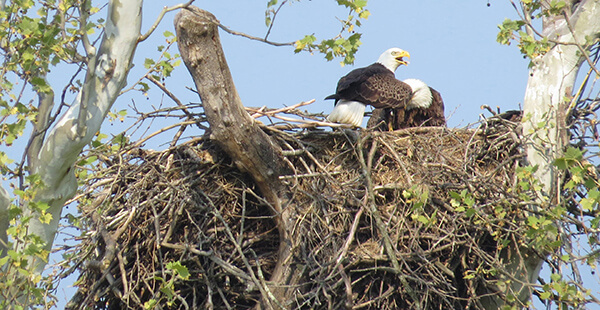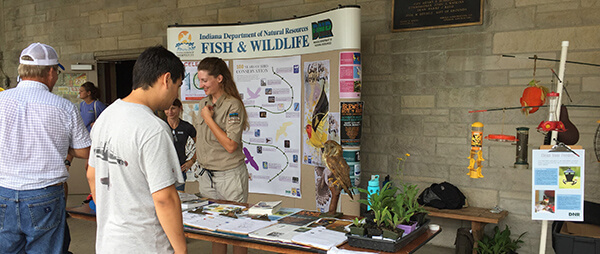
A bald eagle nest. Image courtesy of U.S. Fish & Wildlife Service.
- I found an injured bird – what should I do?
If you have an injured bird, please immediately contact your local wildlife rehabilitator.
- I saw a bald eagle, should I report it?
No. Although seeing a bald eagle is very exciting, the Indiana DNR does not collect bald eagle sightings. Please do not report it unless the eagle is marked with bands on its legs or tags on its wings. Bald eagles are becoming quite common in Indiana and can be seen flying all over the state. In the 1980s, Indiana DNR released 73 bald eaglets at Monroe Lake over five years to reintroduce the species to the state. They have been doing well since then. Indiana DNR expects to have at least 300 breeding pairs of bald eagles in Indiana in addition to those that migrate through or spend their winters in the state. Learn more about bald eagles.
- I found a bald eagle or an osprey nest, should I report it?
Yes, we welcome information on eagle and osprey nests. Please stay at least 330 feet (about the length of a football field) from the nest while observing it to minimize disturbance to the nesting birds. Please do not make the location of the nest public because these birds are protected species.
Report the nest to dfw@dnr.IN.gov with the following information:
- A specific location, like the nearest address or a GPS location. Alternatively, you can take a screenshot of a map or satellite image and mark where it is.
- A photo of the nest. Photos can be taken with a cell phone from a distance during the fall and winter because the nests are large and visible.
- Whether a bald eagle/osprey was sitting in the nest or next to it. If a bald eagle/osprey was present, describe what you saw the birds doing at the nest.
Thank you for your support of Indiana’s eagles and ospreys. Learn more about the bald eagle and the osprey.
- I found a dead bald eagle, what should I do?
If you find a dead bald eagle, first check for bands around the legs. Metal bands are attached to some birds’ legs to track them, and the Indiana DNR used to band them in the late 1980s and ‘90s. If you find a band, please let us know the inscription on the band and send a photo of the band to dfw@dnr.IN.gov.
If no bands are present, please contact your local conservation officer. A conservation officer will retrieve the dead eagle for you. Do not possess the eagle because doing so is illegal according to the Bald and Golden Eagle Protection Act and the Migratory Bird Treaty Act.
When a dead bald eagle is salvaged and no foul play has been detected, the carcass will be sent to the National Eagle Repository.
Thank you for your support of Indiana’s eagles. Learn more about the bald eagle.
- What should I do when a hawk or owl is attacking my backyard poultry?
First, protect your poultry by:
- Strengthening your current enclosure. Find any areas where a raptor can enter and secure them with more enclosure material, like fencing or netting.
- Preventing poultry from leaving the enclosure during dawn, dusk, or night when predators are most active.
- Modify the area around the enclosure to prevent raptors from perching near the enclosure and spying on poultry. Use the term “bird perch deterrent” in your search engine to find products that prevent birds from perching.
If these methods do not work, please contact your district wildlife biologist for further guidance.
Indiana residents having conflicts with birds can help the Indiana DNR collect information by using the wildlife complaint form.
- What should I do when a hawk is attacking the birds at my feeder?
Hawks typically hunt around bird feeders during the summer and fall when juvenile hawks are numerous. Juvenile hawks are inexperienced hunters and tend to hunt around locations where prey, like small songbirds, is concentrated. These young hawks will move on when prey is no longer present. Try removing bird feeders for two weeks so that the hawk(s) will find a new location to hunt. In the meantime, remove old seed and clean your feeders with a 10% bleach solution to keep birds in your area healthy.
- I have a hawk/owl trapped in a warehouse—what should I do?
If you have a hawk or owl trapped in a warehouse or large building, please do the following:
- Stop or minimize activity in the building. The hawk will fly to the highest point in the building because it is scared and stressed. Reducing activity will reduce stress and help the bird become more comfortable so that it can move to lower areas in the building with open doors or windows.
- Open all doors and windows, if possible.
- Turn off all lights. This will reduce stress to the hawk and may attract it to open doors or windows.
- Place a shallow container of water close to but outside of the doors to attract the hawk to the outside. Hawks trapped in buildings will be dehydrated and will seek water.
- Do not feed the hawk. Doing so will provide an incentive for the hawk to stay in or near the building and may lead to the hawk getting trapped again.
If these methods do not work, please contact your district wildlife biologist for further guidance.
Indiana residents having conflicts with birds can help the Indiana DNR collect information by using the wildlife complaint form.
- There are birds causing damage to my property—what should I do?
Please contact your district wildlife biologist for further guidance.
Indiana residents having conflicts with birds can help the Indiana DNR collect information by using the wildlife complaint form. More information about human-wildlife conflicts can be found at the Living with Wildlife webpage.
- I found a young bird on the ground, is it injured or sick?
In the spring and summer, a fully feathered young bird on the ground is normal to see. It often is not sick or injured.
First, look for signs of disease or injury. If the bird looks sick or injured, please immediately contact your local wildlife rehabilitator.
If the young bird does not look sick or injured and is only sitting on the ground, please leave the bird where it is unless it is in danger (e.g., on a well-traveled road). Young fledglings that are learning to fly will remain on the ground. Their parents can find and care for them even if you do not see them in the area.
- I found a sick bird – what should I do?
Please report sick birds (or birds that died of unknown causes) to the wildlife health reporting system. If the bird looks as though it can be retrieved by a professional and treated, please immediately contact your local wildlife rehabilitator.
- Why is a hawk/owl attacking my family and/or pets? What should I do?
Hawks typically act aggressively during the spring and summer when they are nesting. They do this to defend their nest and chicks. Because juvenile hawks are inexperienced hunters, they may also attack small pets. Some options for managing raptor attacks are to avoid the area where the raptors are acting aggressively. If there’s a nest, avoid the area until the nest no longer has chicks. If avoidance is not possible or the hawk is endangering human health or safety, please contact your district wildlife biologist. Indiana residents having conflicts with birds can help the Indiana DNR collect information by using the wildlife complaint form.

Division of Fish & Wildlife staff answer questions about birds at the Indiana State Fair.

